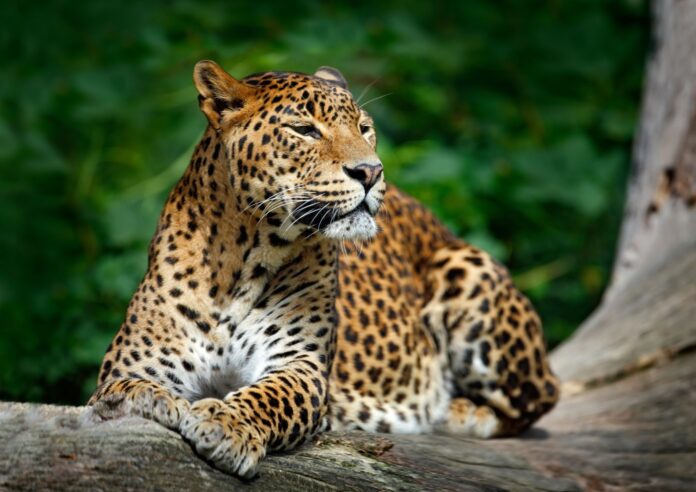
With its rolling hills, misty landscapes and unique biodiversity, the Horton Plains National Park holds a special place in the hearts of nature enthusiasts and conservationists.
Its iconic World’s End cliff, cloud forests and picturesque waterfalls are just a few of the awe-inspiring features that make this small 32-sq.km park a must-visit destination. Like many other natural habitats around the world, Horton Plains too faces challenges such as habitat degradation, invasive species and impacts of climate change.
Finding a leopard (Panthera pardus kotiya) at the Horton Plains National Park was extremely difficult before 2021. The ‘process of habituation’ (being accustomed or used to something) took place after 2021 when a female leopard got habituated and birthed three cubs here and the cubs got habituated through their mother.
As of late, when compared to past years, leopards are seen more often in Horton Plains. The increasing frequency of leopard sightings may seem like a positive development, but it may also be indicative of a problem. As leopards get habituated to humans and vehicles, a dangerous situation could arise for both animals and humans. Habituated leopards may become more aggressive and territorial, posing a threat to tourists who venture too close.
With Sri Lanka Leopard Day being celebrated on August 1 (Tuesday), it is crucial to address this issue to minimize a human leopard conflict to safeguard this iconic creature.
Here are a few guidelines:
- Visitors should be responsible and respectful when entering habitats such as the Horton Plains National Park. They should follow strict guidelines and stay within designated areas to minimize the disturbance to wildlife.
- The authorities, meanwhile, need to enforce stricter regulations, monitor leopard movements and behaviours more closely and launch public awareness campaigns to educate tourists, both local and foreign.
The goal is to balance conservation and tourism in a responsible and sustainable manner.

Habituation processes for leopards can vary from one national park to another, depending on the park’s management practices. The Horton Plains National Park has a unique approach when compared to Yala, Wilpattu or Kumana National Parks.
With visitors to the Horton Plains National Park being allowed to walk on designated roads and trails (unlike the other parks where visitors are restricted to vehicles), leopards may become accustomed to the presence of humans on foot. This can lead to a different level of habituation compared to other parks where leopards primarily encounter humans in vehicles.
Thus, this type of habituation at the Horton Plains National Park may have implications for leopard behaviour – these animals could exhibit a higher tolerance for humans on foot and not see humans as a direct threat.
However, it is important to note that the level of habituation and behaviour of leopards can also vary on an individual basis, even within the same national park.
Therefore, visitors to the Horton Plains National Park need to keep in mind some measures to avoid conflict with wild animals:
- Stay on designated paths: this is to minimize impact on the fragile ecosystem.
- Respect wildlife: keep a respectful distance from wildlife and observe them without disturbing their natural behaviour. Do not approach or feed animals.
- Leave no trace: take back your trash and dispose of it correctly in the designated bins outside the park.
- Follow park rules and guidelines: restrict noise, do not litter or resort to any activity that may harm the environment.
The Horton Plains National Park, relatively small compared to other national parks dotting the country, is in close proximity to tea estates and human settlements.
The encroachment of human activities and the expansion of tea estates near the park can result in a loss of natural habitat for leopards. This, in turn, may lead to increased contact between leopards and humans as leopards may venture out of the park boundaries in search of prey in the form of livestock or suitable habitat. This scenario could trigger conflicts and lead to retaliatory killings on the part of humans, further escalating the conflict.
To mitigate human-leopard conflicts, implementation of management strategies and conservation measures is crucial. These include: creating buffer zones to reduce direct contact; educating local communities on leopard behaviour, their ecological importance and proper measures to minimize conflicts and foster coexistence; implementing livestock protection measures such as improved enclosures; and research and monitoring.
The Wildlife and Nature Protection Society (WNPS) and the Rain Forest Alliance are carrying out awareness programmes among the local communities.
Adopting a holistic approach that combines habitat preservation, research, education and community involvement, is important for peaceful co-existence with all wild animals including leopards. Therefore, let us strive to live in harmony with nature to ensure the long-term survival of our invaluable wildlife.
| August 1 is Sri Lanka Leopard Day | |
| The declaration of Sri Lanka Leopard Day on August 1 is a significant milestone in the conservation of the country’s only apex predator.While the Wildlife and Nature Protection Society (WNPS) played a major role in proposing and advocating for this special day, the confirmation of Panthera pardus kotiyaas an endemic sub-species through the thesis of Dr. Sriyanie Miththapala highlights the importance of protecting this unique leopard population.Dr. Miththapala’s thesis also turns the spotlight on understanding the biodiversity and conservation needs of the Sri Lankan leopard, a keystone species, and provides a scientific basis for targeted conservation actions, policy-making and public awareness initiatives.The important role played by leopards in the ecosystem include: Trophic cascade effects: As top predators, leopards have a cascading impact on lower trophic levels. By regulating the population of herbivores (deer, antelope and wild boar), they prevent overgrazing, helping to maintain a healthy balance within the ecosystem. This ‘trophic cascade’, has far-reaching effects on the entire food web. Preservation of biodiversity: Leopards have a broad diet, capable of adapting to various prey species and habitats. By preventing the dominance of a single prey species, leopards contribute to biodiversity in the survival of numerous other plant and animal species. Ecological resilience: Leopards help maintain ecological resilience (the ability of an ecosystem to withstand and recover from disturbances). Their absence can disrupt the delicate balance and lead to cascading ecological consequences. Indicator of ecosystem health: The presence of leopards is often an indicator of a healthy and well-functioning ecosystem. Their decline or disappearance may signify habitat degradation, loss of prey species or increased human-wildlife conflicts. Therefore, leopards are a barometer to measure the overall health and integrity of an ecosystem. |
Source – The Sunday Times














